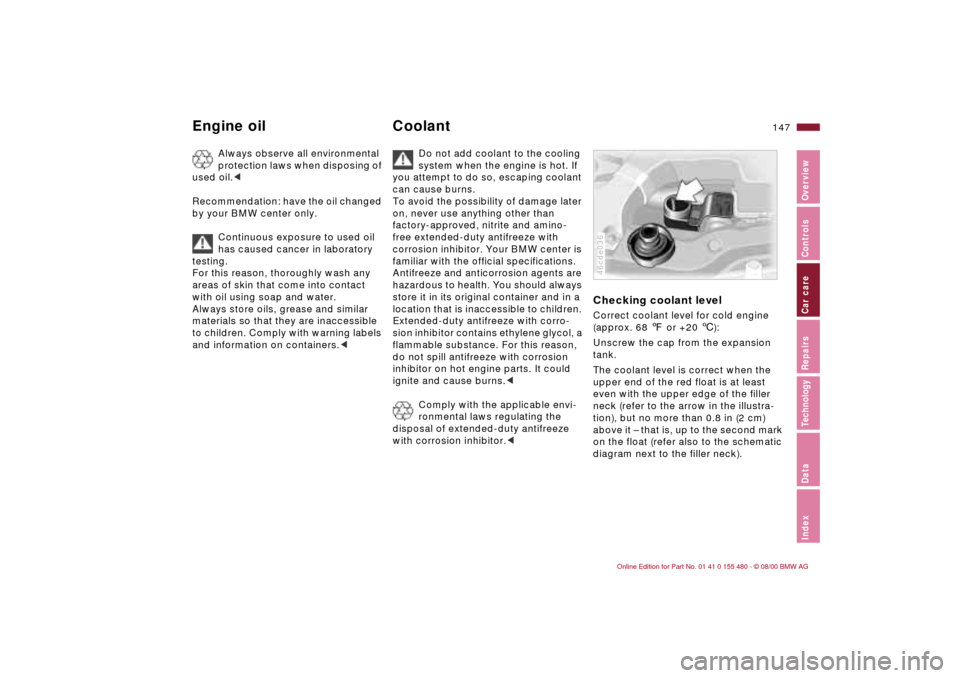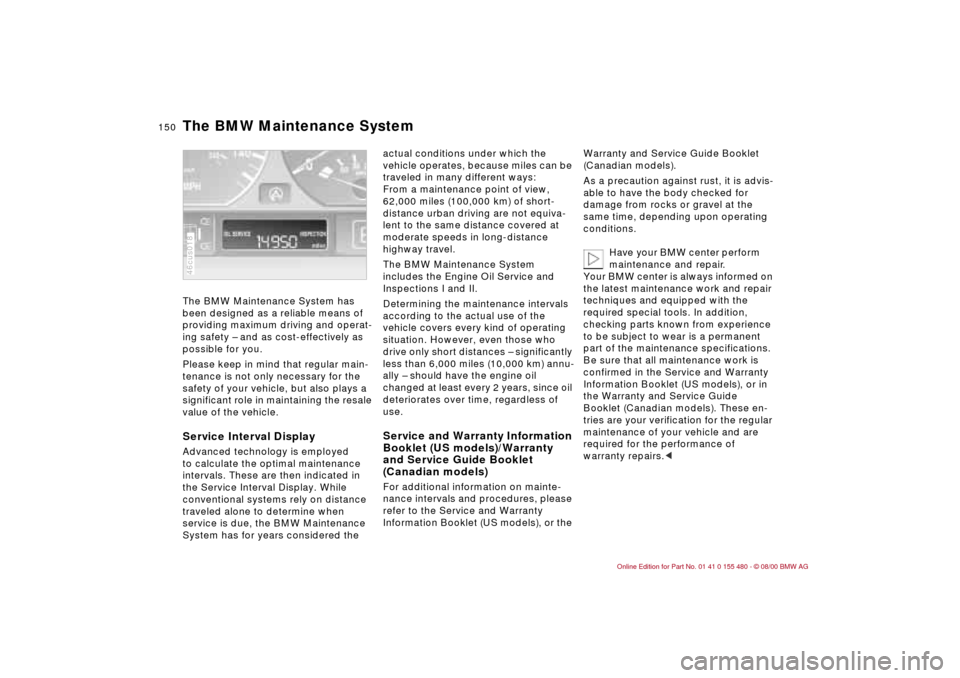oil BMW 325Ci CONVERTIBLE 2001 E46 User Guide
[x] Cancel search | Manufacturer: BMW, Model Year: 2001, Model line: 325Ci CONVERTIBLE, Model: BMW 325Ci CONVERTIBLE 2001 E46Pages: 215, PDF Size: 2.1 MB
Page 147 of 215

147n
IndexDataTechnologyRepairsCar careControlsOverview
Engine oil Coolant
Always observe all environmental
protection laws when disposing of
used oil.<
Recommendation: have the oil changed
by your BMW center only.
Continuous exposure to used oil
has caused cancer in laboratory
testing.
For this reason, thoroughly wash any
areas of skin that come into contact
with oil using soap and water.
Always store oils, grease and similar
materials so that they are inaccessible
to children. Comply with warning labels
and information on containers.<
Do not add coolant to the cooling
system when the engine is hot. If
you attempt to do so, escaping coolant
can cause burns.
To avoid the possibility of damage later
on, never use anything other than
factory-approved, nitrite and amino-
free extended-duty antifreeze with
corrosion inhibitor. Your BMW center is
familiar with the official specifications.
Antifreeze and anticorrosion agents are
hazardous to health. You should always
store it in its original container and in a
location that is inaccessible to children.
Extended-duty antifreeze with corro-
sion inhibitor contains ethylene glycol, a
flammable substance. For this reason,
do not spill antifreeze with corrosion
inhibitor on hot engine parts. It could
ignite and cause burns.<
Comply with the applicable envi-
ronmental laws regulating the
disposal of extended-duty antifreeze
with corrosion inhibitor.<
Checking coolant levelCorrect coolant level for cold engine
(approx. 68 7 or +20 6):
Unscrew the cap from the expansion
tank.
The coolant level is correct when the
upper end of the red float is at least
even with the upper edge of the filler
neck (refer to the arrow in the illustra-
tion), but no more than 0.8 in (2 cm)
above it Ð that is, up to the second mark
on the float (refer also to the schematic
diagram next to the filler neck).46cde036
Page 150 of 215

150n
The BMW Maintenance System has
been designed as a reliable means of
providing maximum driving and operat-
ing safety Ð and as cost-effectively as
possible for you.
Please keep in mind that regular main-
tenance is not only necessary for the
safety of your vehicle, but also plays a
significant role in maintaining the resale
value of the vehicle.
Service Interval DisplayAdvanced technology is employed
to calculate the optimal maintenance
intervals. These are then indicated in
the Service Interval Display. While
conventional systems rely on distance
traveled alone to determine when
service is due, the BMW Maintenance
System has for years considered the 46cus018
actual conditions under which the
vehicle operates, because miles can be
traveled in many different ways:
From a maintenance point of view,
62,000 miles (100,000 km) of short-
distance urban driving are not equiva-
lent to the same distance covered at
moderate speeds in long-distance
highway travel.
The BMW Maintenance System
includes the Engine Oil Service and
Inspections I and II.
Determining the maintenance intervals
according to the actual use of the
vehicle covers every kind of operating
situation. However, even those who
drive only short distances Ð significantly
less than 6,000 miles (10,000 km) annu-
ally Ð should have the engine oil
changed at least every 2 years, since oil
deteriorates over time, regardless of
use.Service and Warranty Information
Booklet (US models)/Warranty
and Service Guide Booklet
(Canadian models)For additional information on mainte-
nance intervals and procedures, please
refer to the Service and Warranty
Information Booklet (US models), or the Warranty and Service Guide Booklet
(Canadian models).
As a precaution against rust, it is advis-
able to have the body checked for
damage from rocks or gravel at the
same time, depending upon operating
conditions.
Have your BMW center perform
maintenance and repair.
Your BMW center is always informed on
the latest maintenance work and repair
techniques and equipped with the
required special tools. In addition,
checking parts known from experience
to be subject to wear is a permanent
part of the maintenance specifications.
Be sure that all maintenance work is
confirmed in the Service and Warranty
Information Booklet (US models), or in
the Warranty and Service Guide
Booklet (Canadian models). These en-
tries are your verification for the regular
maintenance of your vehicle and are
required for the performance of
warranty repairs.<
The BMW Maintenance System
Page 151 of 215

151n
IndexDataTechnologyRepairsCar careControlsOverview
Washing your vehicle You can have your BMW washed in
an automatic car wash, even when it
is new. Car wash systems that do not
employ brushes are preferable, refer to
page 157.
Wipe away tough dirt and loosen and
remove dead insects before washing
the vehicle.
In order to avoid spots, do not wash the
vehicle when the hood is warm, or
during or immediately after exposure to
strong sunlight.
When using an automatic car wash, be
sure that:
>The car wash system is suited for the
dimensions of your vehicle.
>No damage will occur on vehicles
with attached body accessories (such
as spoilers or antennas). Consult the
car wash operator if necessary.
>The wheels and tires of your vehicle
cannot be damaged by the convey-
ance devices of the car wash system.
>The vehicle is cleaned with minimum
brush pressure, and that ample water
is available for washing and rinsing.Vehicles with rain sensor:
Clean the windshield regularly. Wax
from automatic car washes or insects
can cause malfunctions in the function
of the rain sensor.
Deactivate the rain sensor when
going through car washes (refer to
page 77) Ñ otherwise, the wipers could
be damaged if they inadvertently start
working.<
Parts of the vehicle that are inaccessi-
ble to the automatic washer Ð such as
door sills, door and hood edges, etc. Ð
should be cleaned by hand.
In the winter months, it is especially
important to be sure that the vehicle is
washed on a regular basis. Large quan-
tities of dirt and road salt are difficult to
remove, and they also damage the
vehicle.
If spray wands or high-pressure
washers are used, be sure to
maintain an adequate distance between
the spray source and the vehicle's sur-
face. Inadequate distance and exces-
sive pressure can damage or weaken
the finish, making it more susceptible to
subsequent attack. In addition,
moisture could penetrate to vehicle
components, leading to long-term
damage.<
When cleaning the headlamps,
please observe the following: do
not wipe dry with a cloth (scratches).
Never use abrasives or strong solvents
to clean the covers. Remove dirt and
contamination (such as insects) by
soaking with BMW Car Shampoo and
then rinsing with plenty of water.
Always use a deicer spray to remove
accumulated ice and snow Ð never use
a scraper.<
After washing the vehicle, apply
the brakes briefly to dry them.
Braking efficiency might otherwise be
reduced by the moisture and the brake
rotors could also be corroded.<
Caring for your vehicle
Page 152 of 215

152n
Caring for your vehicleExterior finish To provide effective corrosion protec-
tion, multilayer paintwork is applied at
the factory. Cataphoretic immersion
priming techniques are supplemented
using special body-cavity protectants,
with the application of specially-devel-
oped and extensively tested materials.
A layer of flexible PVC is first applied to
the undercarriage. Following this, a
comprehensive undercoating treat-
ment with a wax-based protectant is
applied. Regular maintenance makes
an important contribution to maintaining
the safety and value of your vehicle.
Increasing awareness of the effects
of harmful environmental factors on
vehicle finishes have led paint and
vehicle manufacturers to initiate
ongoing programs designed to further
improve the durability of their finishes.
Despite this, environmental factors that
occur locally or regionally can have
negative effects on the finish of your
vehicle. Use the factors to determine
the frequency and extent of your efforts
to maintain the vehicle finish.Depending upon material and type of
impact (perforation of paint layer),
physical stresses from sand, road salt,
gravel, etc., can cause corrosion to
start extending beneath the finish,
starting at the point of impact.
Road dirt, tar spots, dead insects,
animal droppings (strong alkali effect)
and tree excretions (resins and pollen)
all contain substances capable of caus-
ing damage when allowed to remain on
the finish of your vehicle for any period
of time. This includes spots, etching,
flaking, and separations in the top coat.
In industrial areas, deposits of flue dust,
lime, oily soot, precipitation containing
sulfur-dioxide (acid rain) and other
environmental pollutants will damage
the vehicle's finish unless adequate
care is provided Ð even though this is
generally limited to the outside
horizontal surfaces.In coastal regions, high levels of
atmospheric salt and humidity promote
corrosion.
In tropical zones, temperatures of over
105 7 (+40 6) in the shade prevail, in
addition to heavy ultraviolet radiation
and high humidity. Under these condi-
tions, light paints can reach tempera-
tures of up to 175 7 (+80 6) and dark
paints up to 250 7 (+120 6).
Page 153 of 215

153n
IndexDataTechnologyRepairsCar careControlsOverview
Caring for your vehicleCaring for the vehicle's finish Regular washing is a preventive
measure against long-term effects from
substances that are harmful to the
vehicle's finish, especially if you drive
your vehicle in areas with high levels of
air pollution or aggressive natural
substances (tree resins, pollen).
Nevertheless, you should immediately
remove especially aggressive sub-
stances. Failure to do so can lead to
changes in the paint's chemical
structure or to discoloration. Gasoline
spilled during refueling, oil, grease and
brake fluid should always be cleaned
away immediately, as should bird
droppings.
Any contamination remaining on the
surface of the vehicle will be especially
conspicuous after washing. Use clean-
ing fluid or alcohol with a clean cloth
or cotton pad to remove. Remove tar
spots with tar remover. After cleaning,
the affected areas should be waxed to
ensure continued protection.
Use the cleaning and car-care
products available at your BMW
center.<
Waxing your vehicle Protect the finish using carnauba or
synthetic-based waxes only.
The best way to determine when the
finish needs to be waxed is by noting
when water stops beading on the
surface.
You can use a glass cleaner to remove
any wax or silicone that may have been
left on the windows during waxing.
Use the cleaning and car-care
products available at your BMW
center.<
Paint damageYou can touch up small areas of paint
damage with a BMW spray paint or a
BMW touchup stick.
The paint color code for your vehicle
is provided on a sticker located on the
right hand-side under the hood and
on the first page of your Service and
Warranty Information Booklet
(US models) or Warranty and Service
Guide Booklet (Canadian models).
Damage caused by flying stones,
scratches, etc., must be touched up
without delay to prevent rust from
forming.
If corrosion has started to form in an
area with paint damage, remove all rust
and clean the area. Then prime the area
with a BMW Primer Stick. Finally, apply
the finish coat. Wait a few days, then
polish the repaired area. Finish by
applying a wax preservative.
More extensive paint damage should
be repaired professionally in accor-
dance with the manufacturer's instruc-
tions. Your BMW center uses original
BMW finish materials in accordance
with approved repair procedures.
Page 154 of 215

154n
Caring for your vehicleWindow careYou can use window and glass cleaner
to clean inside window surfaces and
mirrors without smearing and streaking.
Never use polishing pastes or abrasive
(quartz) cleansers on mirror lenses.
Clean the wiper blades with soapy
water. The wiper blades should be
replaced twice a year Ð before and after
the winter months. This is especially
important for vehicles with a rain
sensor.
Use only wiper blades approved
by BMW.<
Caring for other vehicle
components and materials Light-alloy wheels should be treated
with alloy wheel cleaner, especially
during the winter months. However, do
not use aggressive products contain-
ing acids, strong alkalis or abrasive
cleaning agents, nor steam cleaners
operating at temperatures above
140 7 (+60 6) (follow the manufac-
turer's instructions).
If your vehicle has chrome parts
*, such
as the window frames and door handles,
clean these parts carefully with ample
clean water and a shampoo supplement
if desired, especially if they have an
accumulation of road salt. Use a chrome
polish for an additional treatment.
Plastic components, vinyl upholstery,
headliners (hardtop), lamp lenses, the
clear cover of the instrument panel and
components with a sprayed dull black
surface can be cleaned with water (add
plastic shampoo as required). Do not
allow moisture to soak through the
seats or headliner (hardtop). Never use
solvents such as lacquer thinner,
heavy-duty grease remover, fuels, or
similar substances. Rubber components should be cleaned
with water only; a rubber treatment or
silicone spray may also be applied.
Do not remove safety belts to clean
them. Clean them with mild soapy
water only. Do not use chemicals or dry
cleaners to clean safety belts, since this
could damage the belt fabric.
After cleaning, never allow the inertia
reel to retract the belts until they are
completely dry. Dirty safety belts
prevent the inertia reel mechanism from
retracting the strap properly, and thus
constitute a safety hazard.
Heavily soiled floor carpets and mats
*
can be cleaned with an interior cleaner.
The floor mats can be removed from
the vehicle for cleaning.
Use only a damp cloth to clean trim
panels made of real wood
* and other
parts constructed of real wood
*. Follow
up by drying with a soft cloth.
Use the cleaning and car-care
products available at your BMW
center.<
Page 156 of 215

156n
Caring for your vehicleWe recommend that you perform this
procedure twice a year on leather
exposed to normal use.
Spills should be wiped up immediately.
Remove grease and oil stains by
dabbing with spot remover. Avoid
rubbing.
If the upholstery is to be exposed to
intense sunlight or if the vehicle is to be
stored for an extended period, cover all
leather surfaces (or, better yet, the
windows) to prevent fading.
Use the cleaning and car-care
products available at your BMW
center.<
Cleaning agents can contain
substances that are dangerous or
that pose health risks. For this reason,
always comply with the warnings and
danger notices on the packaging.
Open the doors or windows on your
vehicle whenever cleaning the interior.
Never clean your vehicle with solvents
or other materials not specifically
intended for this purpose.<
Page 160 of 215

160n
Vehicle storage
If you plan on parking the vehicle
for more than three months, have
the maintenance operations described
on this page performed.<
Preparations for storageHave your BMW center perform the
following procedures:
1 Clean and apply a rustproofing agent
or other treatment to the engine,
engine compartment, undercarriage,
axles and major components in
accordance with approved repair
procedures. First wash the vehicle
surface, then clean the interior,
following up with paint and chrome
care, after which you clean the
rubber seals for the hood and doors.
2 Change the engine oil and oil filter at
operating temperature. As an addi-
tional corrosion protection measure,
an anticorrosive agent can be added
to the engine in accordance with the
manufacturer's instructions.
3 Check the coolant level and concen-
tration and top up if necessary.
4 Check the fluid level of the wind-
shield washer fluid reservoir and top
up if necessary.
5 Fill the fuel tank completely to pre-
vent the formation of condensation.
6 Increase the tire inflation pressure to
51 psi (350 kilopascal).
Before parking the vehicle1 To prevent the brake discs and
drums from corroding, dry the park-
ing and footbrake by applying the
brakes.
2 Park the vehicle in a covered, dry and
well-ventilated space. Place the
transmission in 1st gear or set the
selector lever to the "P" position.
Chock the wheels to prevent the
vehicle from rolling if necessary. Do
not set the parking brake.
3 Remove the battery, charge it
completely and store it in a cool (but
frost-free) room.
4 Remove the hardtop and store
separately. Refer to page 130.
5 Close the convertible top.During storageRecharge the battery every six months.
If it is not recharged, it will not be
serviceable. Every time the battery is
drained, especially over extended
periods, its service life is reduced.
Removing the vehicle from
storageRecharge the battery if the "Magic
Eye"
* turns black. Refer to page 176.
Then have Inspection I performed by
your BMW center, including a brake
fluid replacement if necessary. Refer
to the Service Manual.
Page 199 of 215

199n
IndexDataTechnologyRepairsCar careControlsOverview
Capacities
Notes
Fuel tank
Reserve gal. (liters)
gal. (liters)approx. 16.6 (approx. 63)
approx. 2.1 (approx. 8)Fuel specification: page 27
Windshield/headlamp washer system quarts (liters) approx. 5.6 (approx. 5.3) Specifications: page 144
Cooling system including heater circuit quarts (liters) approx. 8.9 (approx. 8.4) Specifications: page 147
Engine oil filter change quarts (liters) approx. 6.9 (approx. 6.5) BMW High Performance
Synthetic Oil
Specifications: page 146
Manual and automatic transmission, transfer box
and differentialÐ Lifetime fluid, no fluid
change required
Page 204 of 215

Everything from A to Z
A
ABS (Antilock Brake System) 22,122
Accessories 6
Activated-charcoal filter 106,180
Adaptive Transmission Control (ATC) 73,188
Adding engine oil 145
Adding washer fluid 144,199
Adjusting backrest 52
Adjusting headrests 53
Adjusting the steering wheel 57
Adjusting the temperature 98,104
Adjusting thigh support 54
Air conditioner 96
Air distribution 98,104
Air nozzles 96,102
Air outlets 96,102
ventilation 96,102
Air pressure, tires 27,132
Air supply 98,105
Airbags 21,61 ,159 ,189
sitting properly with 62
Alarm system 42
Antenna 129
Antenna, Diversity 190 Antifreeze
147
radiator 127
Antilock Brake System (ABS) 22,122
Anti-theft alarm system 42
Aquaplaning 121,132
Armrest 110
ASC+T (Automatic Stability Control plus
Traction) 22,88
Ashtray front 111
rear 112
ATC (Adaptive Transmission Control) 73,188
Attach vacuum cleaner 112
AUC (Automatic recirculated-air
control) 105
Automatic car washes 151
Automatic climate control 102
remove window
condensation 105
Automatic cruise control 79
Automatic dimming, interior rearview mirror 58
Automatic recirculated-air control (AUC) 105
Automatic Stability Control plus Traction
(ASC+T) 22,88 Automatic transmission with
Steptronic 21,73
Automatic windshield washer 77
Average consumption 85
Average speed 86
Avoiding unwanted alarm 43
Axle loads 198
B
Backrest adjusting 52
locking 21,55
releasing 55
Backup lamps 72
bulb replacement 169
Battery 176,200
capacity 200
charge current 20,176
charging 178
discharged 183
removal and
installation 178
Belts 60
Beverage holder 111
Blower 98,105
BMW High Performance Synthetic Oils 146
BMW Maintenance System 150 BMW sports seat
54
Bore 196
Brake fluid 148
Brake hydraulic system 20
Brake lamps, bulb replacement 169
Brake pads 22,126
Brake system 126
Brakes 125
malfunctions 126
Break-in procedures 120
Bulb replacement 166
C
California Proposition 65 Warning 161
Capacities 199
Car Memory 59
Car radio 129
reception 129,190
refer also to the Radio
Owner's Manual
Car washes 151
Care convertible top 157
exterior 152
interior 154
leather upholstery 155
rubber seals and
components 127